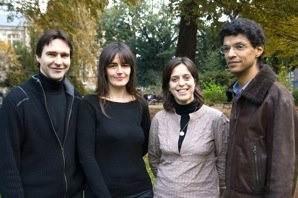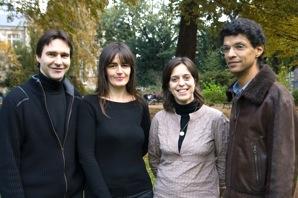The French ensemble’s Web site tells us:
Since its inception in 1999, Ensemble Zellig has focused on innovation and experimentation. Like Woody Allen's film chameleon, Zelig [the group added an extra “l” in their name so as not to violate Allen’s copyright], the flexibly-sized ensemble is fully at ease traveling through time and musical styles.

Championing a set of composers reflecting fusion of past and present in one way or another, the group made its West Coast debut Sunday night in a concert sponsored by Cal Performances at Hertz Hall on the UC Berkeley campus — and what a breath of fresh air it was! Although four of the five composers performed were professors, there was nothing abstruse about the music. You didn’t need charts and graphs to understand it, just a couple of ears and a willingness to accept that occasional melody and a few triads no longer condemn a work as hopelessly outdated. And each composer was his own man despite shades of predecessors flitting in from time to time.
The highlight of the afternoon for me was Don Freund’s (b. 1947, Pittsburgh, Penn.) Crunch Time (2010). Like all the composers on the program (played without intermission), Freund was not afraid of repetition. So much the easier for the audience to grasp a bit of what is going on in a piece. Pounding dissonances form the bookend “crunch” of the structure, the central portion of which consists of a faster set of riffs and syncopations taken over by an earworm of a tune marked “insolent, punk.” Freund writes that the tune is “not a pretty one,” and it “refuses to go anywhere or go away.” Not a problem. It’s a lovable ugly, especially its last four notes, which reminded me of Alex North’s film music for Cleopatra's entrance into Rome. Pianist Jonas Vitaud and cellist Silvia Lenzi effectively provided the initial crunch, joined by clarinetist Etienne Lamaison.
Philippe Hersant (b. 1948, Rome) was represented by two sets of short pieces, Five Miniatures (1995) and Six Bagatelles (2007, 2010). The miniatures were superbly performed by solo flutist Anne-Cécile Cuniot. Her extended techniques (multiphonics, blowing toneless air, and so on) were executed flawlessly. Even more important, Hersant’s use of the techniques made them little Zeligs, things that sounded perfectly natural and appropriate and did not call attention to themselves, whatever their context.
Absorbing Past Advances
This is what the 21st century is about right now, absorbing the advances in the last century, not continually rejecting all past practices and fruitlessly trying to make each new work sui generis. The result is evocation at times: an Irish jig in the third number of the Miniatures, Japanese approaches in the fourth, perhaps a tarantella in the conclusion. The same went for the Bagatelles for clarinet cello and piano: hints of an Italian tune in the second, a chirping clarinet right out of Ravel’s orchestration of the “Schmuÿle” theme in Mussorgsky’s Pictures at an Exhibition.
Gerald Shapiro’s (b. 1942, Philadelphia) Change and End (2010) was perhaps the most heartfelt work on the program. The composer’s mother died during the composition of its several short movements, leading Shapiro to write with a greater seriousness of purpose, starting the last movement on notes taken from his mother’s name. An earlier movement became infused with alternating notes similar to those used in the plainchant for the dead, hinted at with the gentle restraint found in Gabriel Fauré’s Pavane.
The two remaining composers took their inspiration from devices found in the practice of minimalism: extensive repetition and gradual movement in and out of synchronization. Edmund Campion (b. 1957, Dallas) took the most systematic approach, hooking up all four of the performers to earphones with click tracks generated by an onstage computer. His Auditory Fiction claims to be “cinema for the ears,” an “imaginary narrative.” For narratives, I’ll take Strauss any day: None whatsoever was apparent to me in this piece, in which somewhat pedestrian materials were made temporarily fascinating not only through synching and desynching, but also through meticulously generated speedings up and slowings down of tempo at different rates among instruments. No Alex North in this piece, but plenty of Steve Reich, and innovation that will benefit future composers.
The title for Philippe Leroux’s (b. 1959, Boulogne) PPP for flute and piano (1993) has not been explained, but it does not refer to dynamics, since most of it is mezzo-piano or louder. Perhaps it refers to the pops of air in the flute that begin the piece, or the intensive repetition of single groups of notes that permeates, structures, and reels in the disparate other elements in the music. Sometimes, the music is a “game of pairs” like in Béla Bartók’s Concerto for Orchestra. Always, there are quick changes that maintain intense interest over the nine-minute duration of the piece.
All in all, a highly satisfying afternoon. Ensemble Zellig should be welcomed heartily the next time they return, which I hope will be soon. I’ll probably still be humming that “insolent” tune of Freund’s, and need a replacement.

